#90's neo psych
Text

Surrender by The Chemical Brothers
Freestyle Dust / Virgin / Astralwerks
1999
Big Beat / Techno / House / Neo-Psychedelia / Breakbeat / Progressive House / Funky Breaks
#big beat#techno#house#house music#neo psychedelia#neo psych#breakbeat#progressive house#funky breaks#dance#dance music#electronic#electronic music#music#90s#90s music#90's#90's music
18 notes
·
View notes
Text
The AM: June 27, 2022

What are the edges of off-beat easy listening? We've got vintage Swedish psych and American jazz-fusion, '90s trip-hop and brand new Canadian neo-classical composition. Excessively eclectic or appropriately laid-back? Judge for yourself. As always, tracklist is after the break.
Listen on Soundcloud
Stream on CJSW
Spotify playlist
Hour One:
Field II: Slow Drift
Richard Reed Parry, Susie Ibarra • Heart and Breath: Rhythm and Tone Fields
Next Time Could Be Your Last Time
Forgiveness • Next Time Could Be Your Last Time
Seventh String
Makaya McCraven • In These Times
Ital is Vital
Shabaka • Afrikan Culture
Kiddo Caterpillar
Salamanda • ashbalkum
Pacific Coast Highway
Patricia Wolf • See-Through
Purgatory for Vancouver Buzz Bands
The Golden Age Of Wrestling • Crossface Chicken Wing
Echoes
Rival Consoles • Single
Spell (Morgan Greenwood Remix)
Hermitess • Ace of Cups
Crucible
Sanctums • Neon Wraith
Hour Two:
Tropicola
Stringtronics • Mindbender
Estrela Acesa
Sessa • Estrela Acesa
The Not Real Lake
Loving • Loving
Like a Fable
Shintaro Sakamoto • Like a Fable
Guardians of Eden
Wax Machine • Hermit's Grove
Patience is Virtue
William S. Fischer • Circles
There's a Light that Shines
William S. Fischer • Circles
Zodiac
Badge Époque Ensemble, featuring James Baley • Clouds of Joy
Allt på denna runda jord
Mats Glenngård • Kosterläge
No Heaven
Crystal Eyes • The Sweetness Restored
Hour Three:
Red River
Zoon, featuring Sunnsetter • Big Pharma EP
No Body
Living Hour • Someday Is Today
Anima
Gwenno • Tresor
Some Other Thing
John Glacier • SHILOH: Lost For Words
A Great Escape
Stelar Door • Visions of Erehwon
Daydream in Blue
I Monster • These Are Our Children
Mushrooms & Roses
Janelle Monáe • The ArchAndroid
Up 2 Me
Tess Roby • Ideas of Space
Is it Me or is it You?
Kaitlyn Aurelia Smith • Let's Turn It Into Sound
Threads of Memory
Para Palabras, featuring JWMB3 • Two Lakes
Hawk
White Poppy • Paradise Gardens
Listen
Browse
Programming
Podcasts
Support
Donate
Store
Friends
Volunteer
Station
About
News
Contact
Music
0 notes
Link
A new NTWEWY article is out! It elaborates a little on the existing teams and their leaders, as well as other mechanics (such as the shop system)
Here’s a summary:
A new feature of the Reapers' Game are Scramble Slams—you must erase all the orange Turf Noise or other teams to claim locations as your own.
Chain together battles with regular Noise to gain Scramble Points, which you can then exchange for rewards!
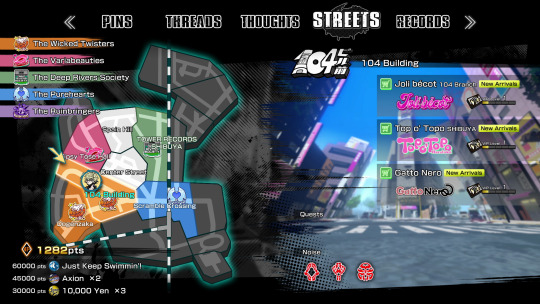
The Ruinbringers are known as the strongest team!
Despite Susukichi’s rather large physique, he’s actually a bit of a chatterbox with a surprisingly high voice.
Just like his favorite game Reversi (similar to Othello), he views the world in black and white.
Tsugumi has little to no interaction with others and doesn’t talk to anyone. Contrary to her frail appearance, she possesses powerful psychic abilities and remains undefeated by other Players.
The plush she carries greatly resembles the mascot of the new brand Gatto Nero—but apparently she’s had it since before the brand had even been established...

The Deep Rivers Society is a group of river enthusiasts whose plan is to survive by being cautious! Their leader Fuya is quite cowardly, but his aversion to conflict is the reason why he’s survived for so long.
The Variabeauties’ leader Kanon gives the Wicked Twisters a crash course in the rules of the Game. Though she’s lacking in flashy psychic powers, she more than makes up for it with wisdom, which has helped her survive the Game thus far.
Motoi is the leader of the Purehearts and his magnetic personality is the reason his team has so many members!

There are more than 40 shops you can visit, each with a unique shopkeeper!
The shopkeeps will reveal a little more of their personality with each visit. Once you increase your friendship rank with them, you may eventually gain some VIP perks!
There are no restrictions when it comes to equipping threads, so you can make whichever character you like wear any fashion item!
There are over 270 types of fashion items!
Top o’ Topo is a new brand whose cute and girly clothes are popular with younger crowds.
Joli Becot, or JB for short, is a stylish new brand for women that also features some cool pieces for men.
There are also a wide variety of restaurants with over 90 types of food!

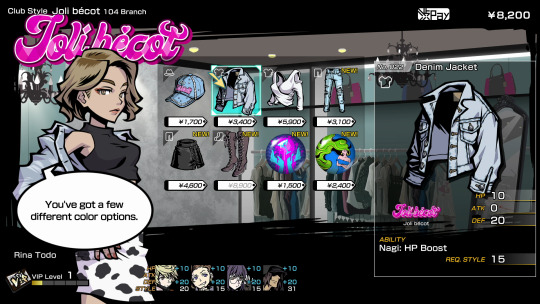
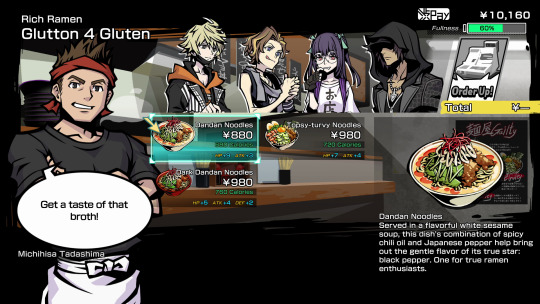
Fret’s psych has also been revealed: Remind!
Remind helps people remember things they’ve forgotten. It activates a mini-game where you need to correct positions to reassemble the scattered memory. Put all the pieces in the right place to complete the reminder!
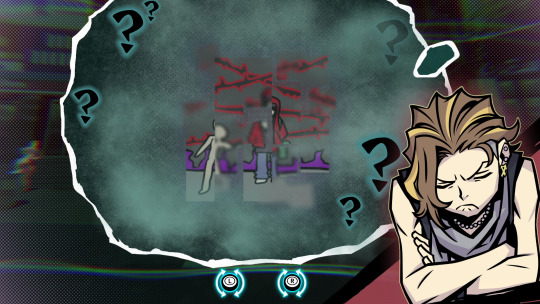
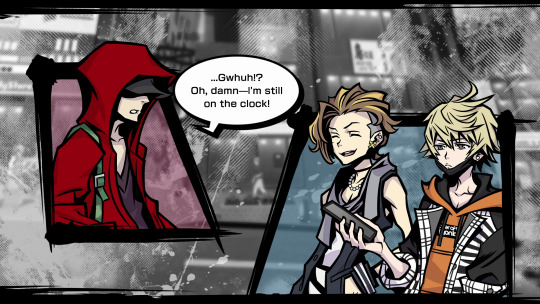
54 notes
·
View notes
Text
1000 Albums, 2020: The Big Lists
Hey folks, I’ve written up my top albums and my top tracks of 2020, but there’s so much music released in a year, and restricting myself to just 30 albums, and 50 tracks is a difficult task.
As a result, I’ve compiled a longer list of my top tracks and albums (without write-ups), for your perusal. This is obviously more for the sake of completeness, but are here in case you’re interested in finding out if I at all rated something you liked this year (or, if you’re Sam, if you want to actually do a detailed comparison).
Want playlists? I’ve got playlists for you too:
My Top 50 Countdown - which I posted yesterday. This provides a sorted countdown of my top tracks from #1 to #50. (50 tracks)
My Top Tracks - a longer list of all the tracks I really rated highly this year. This accounts for a much larger number of artists, and includes most of the tracks I’ve listed below. (169 tracks)
My Top Tracks & Albums - a playlist containing all my top tracks, plus selections from all of my favourite albums of the year. (216 tracks)
My Top Tracks, Albums + Much, Much More - Are you game? Contains a huge, varied collection of music that we listened to this year. I really enjoyed all these tracks, and they provide a much broader collection of albums, artists and genres. (1,014 tracks)
Anyway, without further ado here’s my Top 200 Tracks, and Top 100 Albums:
Top Albums of 2020
100. Winnetka Bowling League - Congratulations (power pop)
99. Locate S, 1 - Personalia (art pop)
98. Dua Lipa - Future Nostalgia (pop)
97. LukHash - Transient Offworld (synthwave)
96. The Drowns - Under Tension (street punk)
95. The Mystic Underground - Wrapped in Riddles (electro disco)
94. Jonathan Wilson - Dixie Blur (Americana noir folk)
93. Mighty Oaks - All Things Go (indie folk rock)
92. Kiesza - Crave (synthpop)
91. Dance Gavin Dance - Afterburner (post hardcore)
90. The O’Reillys and the Paddyhats - Dogs on the Leash (Celtic punk)
89. Warm Digits - Flight of Ideas (krautrock)
88. Dandelion Wine - Le Cœur (Australio dreamfolktronica)
87. Marc Scibilia - Seed of Joy (indie singer-songwriter)
86. Biffy Clyro - A Celebration of Endings (Scottish indie rock)
85. Savant - Void (complextro)
84. Cordovas - Destiny Hotel (Americana folk)
83. TTRRUUCES - TTRRUUCES (wonky pop)
82. The Claudettes - High Times in the Dark (Chicago piano blues)
81. Dustbowl Revival - Is It You, Is It Me (post country)
80. Sea Wolf - Through a Dark Wood (indie folk rock)
79. Cory Wong - The Striped Album (funk rock)
78. Someone - ORBIT II (psych pop)
77. Days N’ Daze - Show Me The Blueprints (H-town thrashgrass)
76. Blossoms - Foolish Loving Spaces (indie pop)
75. Kyros - Celexa Dreams (prog synth rock)
74. Dub Pistols - Addict (dub)
73. Grimes - Miss Anthropocene (dreampop)
72. The Hanging Stars - A New Kind of Sky (psychedelic folk)
71. Neon Trees - I Can Feel You Forgetting Me (indie pop)
70. The Corner Laughers - Temescal Telegraph (folk pop)
69. 3D Stas - Eleven (soiltronica)
68. Pantayo - Pantayo (kulingtang gong pop)
67. The National Parks - Wildflower (folk rock)
66. Pigeon John - Gotta Good Feeling (underground rap)
65. Novo Amor - Cannot Be, Whatsover (indie folk rock)
64. The Explorers Club - The Explorers Club (sunshine pop)
63. Poppy - I Disagree (bubblegum metal)
62. Overcoats - The Fight (indie pop)
61. Chemtrails - The Peculiar Smell of the Inevitable (psychedelic garage pop)
60. Joywave - Possession (indie pop)
59. Heart Bones - Hot Dish (indie pop)
58. Mitochondrial Sun - Mitochondrial Sun (darktronica)
57. L.A. Salami - The Cause of Doubt & A Reason To Have Faith (post blues)
56. Car Seat Headrest - Making a Door Less Open (alt rock)
55. Tunng - Dead Club (folktronica)
54. Butch Walker - American Love Story (glam rock)
53. Polly Scattergood - In This Moment (experimental pop)
52. The Beautiful Fear - The Waltz of the Moonshine Blind (prog rock)
51. The Altogether - Silo (acoustic pop rock)
50. KES - We Home (Trinidadian soca)
49. Man Man - Dream Hunting in the Valley of the In-Between (experimental rock)
48. Creeper - Sex, Death & The Infinite Void (horror punk)
47. Darlingside - Fish Pond Fish (indie folk)
46. Enter Shikari - Nothing Is True & Everything Is Possible (electronicore)
45. Trixie Mattel - Barbara (drag country)
44. City Mouth - Coping Machine (indie pop rock)
43. Bright Eyes - Down In The Weeds Where The World Once Was (indie rock)
42. The Texas Gentlemen - Floor It!!! (heartland rock)
41. Will Wood - The Normal Album (cabaret rock)
40. Maeve Gilchrist - The Harpweaver (harp folk)
39. rook&nomie - me&you (experimental pop)
38. Steep Canyon Rangers & Asheville Symphony - Be Still Moses (orchestral bluegrass)
37. Fiona Apple - Fetch the Bolt Cutters (art pop)
36. Sea Girls - Open Up Your Head (indie pop rock)
35. Michael Franti & Spearhead - Work Hard & Be Nice (reggae fusion)
34. Oneohtrix Point Never - Magic Oneohtrix Point Never (experimental electronica)
33. Ultrahappyalarm - Critical Daydream (happy hardcore)
32. The Living Tombstone - zero_one (Israeli electro rock)
31. The Flaming Lips - American Head (psychedelic rock)
30. Saint Saviour - Tomorrow Again (experimental folk)
29. Post Animal - Forward Motion Godyssey (psychedelic rock)
28. The Jerry Cans - Echoes (Inuit neo-folk)
27. Aloud - Sprezzaturra (blues rock)
26. The Phenomenal Handclap Band - PHB (psychedelic soul)
25. Jason Isbell & The 400 Unit - Reunions (alt country)
24. Badly Drawn Boy - Banana Skin Shoes
23. MOBS - Cinema Paradiso (80s pastiche pop)
22. Jason Wilson - Sumach Roots (eclectic folk)
21. DMA’s - The Glow (Australio indie rock)
20. Cornershop - England Is A Garden (chamber psych)
19. Igorrr - Spirituality and Distortion (baroque breakcore)
18. Eleventyseven - Basic Glitches (synthpunk)
17. Kate Rusby - Hand Me Down (indie folk)
16. Indigo Girls - Look Long (folk rock)
15. Another Sky - I Slept On The Floor (indie rock)
14. Courteeners - More. Again. Forever (post britpop)
13. Dutty Moonshine Big Band - City of Sin (jazztronica)
12. Nelson Kempf - Family Dollar (art folk)
11. Beans on Toast - The Inevitable Train Wreck (drunken folk rock)
10. Joe Wong - Nite Creatures (baroque pop)
9. Luis Pestana - Rosa Pano (experimental electronica)
8. Sufjan Stevens - The Ascension (art pop)
7. MisterWives - Superbloom (indie pop)
6. Lola Marsh - Someday Tomorrow Maybe (Israeli noir pop)
5. Dyble Longdon - Between a Breath and a Breath (chamber folk)
4. Hugo Kant - Far From Home (downtempo nu-jazz)
3. The Lemon Twigs - Songs For The General Public (alt rock)
2. King Gizzard & the Lizard Wizard - K.G. (microtonal psychedelic rock)
1. Ada Rook - 2,020 Knives (electropop concrète)
Top Tracks of 2020
200. Sea Wolf - Forever Nevermore (indie rock)
199. Steep Canyon Rangers & The Asheville Symphony - Easy to Love (orchestral bluegrass)
198. Dandelion Wine - Too Late She Cried (experimental pop)
197. Aloud - Oh Danny (blues rock)
196. Car Seat Headrest - Weightlifters (anti-folk)
195. Michael Franti & Spearhead - I Can Still Feel You (reggae fusion)
194. Dance Gavin Dance - Lyrics Lie (post hardcore)
193. Post Animal - Post Animal (psychedelic rock)
192. La Oreja de Van Gogh - Menos Tú (Spanish indie folk)
191. The Hanging Stars - Heavy Blue (cosmic country)
190. Oneohtrix Point Never - Long Road Home (experimental electronica)
189. Will Wood - I / Me / Myself (cabaret rock)
188. Butch Walker - You Gotta Be Just Who You Are (glam rock)
187. Brothers Osborne - Muskrat Greene (country)
186. Tycho - Easy (downtempo IDM)
185. The Altogether - Brown of Gold (acoustic pop rock)
184. Dua Lipa - Cool (pop)
183. Circa Waves - Jacqueline (indie dance rock)
182. Sangatsu No Phantasia - Rendezvous (Japanese pop rock)
181. Moonchild Sanelly - Bashiri (South African future ghetto punk)
180. Needshes - Love (Uzbek indie pop)
179. The Explorers Club - Ruby (sunshine pop)
178. Osi & the Jupiter - Appalachia (pagan folk)
177. Thievery Corporation - The Forgotten People (Symphonik Version) (orchestral world triphop)
176. Enter Shikari - Marionettes (I. The Discover of Strings) (electronicore)
175. Zuzu - How It Feels (pop rock)
174. Los Mocosos - Viva Los Mocosos (latin funk)
173. DJ Plead - Going For It (mahraganat)
172. Igorrr - Camel Dancefloor (baroque breakcore)
171. Someone - Pull It Together (psych pop)
170. Dizzee Rascal - You Don’t Know (grime)
169. The Corner Laughers - The Accepted Time (power pop)
168. The Claudettes - 24/5 (rock and/or roll)
167. The Ballroom Thieves - Tenebrist (neo Americana)
166. Joe Wong - Day After Day (baroque pop)
165. Porter Robinson - Something Comforting (complextro)
164. Jason Wilson - Happy Little Sisyphus (indie folk)
163. Jason Isbell & the 400 Unit - Be Afraid (alt country)
162. Hayley Williams - Dead Horse (indie pop)
161. Badly Drawn Boy - I Need Somebody to Trust (indie pop rock)
160. Bleached - Stupid Boys (bubblegrunge)
159. Man Man - Lonely Beuys (experimental rock)
158. Dustbowl Revival - Dreaming (neo Americana)
157. The Texas Gentlemen - Easy St. (neo Americana)
156. Maeve Gilchrist - The Storm (harp folk)
155. The Drowns - Them Rats (street punk)
154. Mr. B The Gentleman Rhymer - Frolicholic (chap hop)
153. Zutomayo - Obenkyou Shitoiteyo (Japanese jazz rock)
152. Jonathan Wilson feat. Mark O’Connor - ‘69 Corvette (Americana noir folk)
151. Dub Pistols feat. Natty Campbell - Sound Sweet (dub DnB)
150. Cordovas - I’ma Be Me (Americana folk)
149. The Birthday Massacre - Enter (gothic darkwave)
148. KIDS - The Mourn (indie rock)
147. Kyros - Rumour (prog synth rock)
146. Paul Heaton & Jacqui Abbott - A Good Day Is Hard To Find (pop rock)
145. The O’Reillys and the Paddyhats - James Brian (Celtic punk)
144. The Fizz - The World We Left Behind (MOR pop)
143. Beans on Toast - World Gone Crazy (indie folk)
142. Liraz - Shab Gerye (arab groove)
141. 47 Soul feat. Shadia Mansour & Fedzilla - Border Ctrl (Palestinian shamstep)
140. 3D Stas - Dislocated Minds (soiltronica)
139. Bright Eyes - Tilt-A-Whirl (indie folk rock)
138. Darlingside - Ocean Bed (indie folk)
137. Once and Future Band - Freaks (psych pop)
136. Prizm - We Were Young (synthpop)
135. Z Berg - To Forget You (dreamfolk)
134. L.A. Salami - Things Ain’t Changed (post blues)
133. Kero Kero Bonito - It’s Bugsnax! (hyperpop)
132. Days N’ Daze - Addvice (thrashgrass)
131. Sufjan Stevens - Tell Me You Love Me (art pop)
130. Fiona Apple - Shameika (art rock)
129. Dutty Moonshine Big Band feat. HypeMan Sage - Big Band Fam (jazztronica)
128. Five Finger Death Punch - Leave It All Behind (nu metal)
127. Sundara Karma - Artifice (art pop)
126. TTRRUUCES - Lost Boy (wonky pop)
125. Theory of a Deadman - Ted Bundy (post grunge)
124. The National Parks - I Can Feel It (folk pop)
123. The Innocence Mission - John As Well (ambient folk)
122. King Gizzard & the Lizard Wizard - The Hungry Wolf of Fate (microtonal indie rock)
121. The Jerry Cans - Atauttikkut (Inuit folk rock)
120. Sufjan Stevens - Lamentations (art pop)
119. Pigeon John - They Don’t Make Em Like Me (jazz hip hop)
118. Michael Franti & Spearhead - Lay It All Down (reggae fusion)
117. ARASHI - Party Starters (J-pop)
116. Neon Trees - Used To Like (indie pop)
115. Savant feat. Jahari Medina - Zealot (complextro)
114. Alestorm - Tortuga (pirate metal)
113. MisterWives - Valentine’s Day (indie pop)
112. Alex the Astronaut - Happy Song (indie folk pop)
111. Big Freedia feat. Kesha - Chasing Rainbows (bounce)
110. Cory Wong feat. The Hornheads - Click Bait (instrumental funk)
109. Suzzy Roche & Lucy Wainwright Roche - I Think I Am a Soul (neo Americana)
108. Victoria Anthony - Temporary Tattoo (synthpop)
107. Novo Amor - I Feel Better (indie folk rock)
106. Harper Bloom - Walk My Way (indie folk pop)
105. Badly Drawn Boy - Is This a Dream? (indie pop rock)
104. Bywater Call - Arizona (blues rock)
103. Mitochondrial Sun - Chronotopes (voidgaze)
102. Kronkel Dom - Giftig (Deutsch rap house)
101. The Phenomenal Handclap Band - Riot (nu disco)
100. Woodlock - Collateral (indie folk rock)
99. SKIES - It’s Alright (pop rock)
98. Pinguini Tattici Nucleari - Ringo Starr (Italian indie pop)
97. Warm Digits - False Positive (neo-krautrock)
96. Winnetka Bowling League - Come To The Beach (power pop)
95. ViVii - Whistle (folk pop)
94. Fame on Fire - Roxanne (post-screamo)
93. Tunng - Death Is The New Sex (folktronica)
92. Feuerschwanz feat. Melissa Bonny - Ding (neue Deutsche härte)
91. Jamie Cullum - Don’t Give Up On Me (jazz pop)
90. The Living Tombstone - What I Want (Israeli electro rock)
89. Walk Off The Earth - What’s Love Got To Do With It? (indie pop cover)
88. Hildegard von Blingin’ & Cornelius Link feat. Friar Funk - Pumped Up Kicks (bardcore)
87. Loma - Don’t Shy Away (ambient rock)
86. Pantayo - Heto Na (kulingang gong pop)
85. Gin Wigmore - H B I C (indie rock)
84. Dyble Longdon - Crossbones (chamber folk)
83. DMA’s - Never Before (Australian indie rock)
82. Mighty Oaks - Tell Me What You’re Thinking (indie folk rock)
81. Circles Around the Sun - Landline Memories (instrumental prog rock)
80. Blossoms - Your Girlfriend (indie pop rock)
79. Grimes - 4ÆM (industrial pop)
78. Ada Rook - 2,020 Knives (electropop concrète)
77. Walk Off The Earth - Oh What A Feeling (indie pop)
76. AWOLNATION - Radical (stomp pop)
75. Little Big Town - Bluebird (alt country)
74. Dutty Moonshine Big Band feat. HypeMan Sage - Outlaws (jazztronica)
73. Hugo Kant - Everything Is Transformed (downtempo nu-jazz)
72. King Gizzard & the Lizard Wizard - Intrasport (microtonal indie pop)
71. Stuck On Planet Earth - Higher Than The Drugs (dance rock)
70. Kesha - Potato Song (Cuz I Want To) (pop)
69. joan - want u back (indie pop)
68. MisterWives - Love Me True (indie pop)
67. Butch Walker - Fuck It (I Don’t Like Love) (glam rock)
66. Heart Bones - This Time It’s Different (indie pop)
65. Anamanaguchi feat. meesh - Pop It (glitchhop)
64. Poppy - Concrete (bubblegum metal)
63. Creeper - Cyanide (alt rock)
62. The Lemon Twigs - Only a Fool (alt rock)
61. Purity Ring - stardew (dreampop)
60. Curt Cannabis - Falling Sensation (indie rock)
59. Custard - Funky Again (Bluey’s dad rock)
58. Ryan Hamilton and the Harlequin Ghosts - Newcastle Charm (power pop)
57. Indigo Girls - Howl at the Moon (ectofolk)
56. Cornershop - Highly Amplified (chamber psych)
55. ShockOne - Follow Me (drum n bass)
54. Yelle - Karaté (French hip hop)
53. Ultrahappyalarm - Wanna Cam??? (hyperpop)
52. Biffy Clyro - Tiny Indoor Fireworks (Scottish alt rock)
51. Heaven Pegasus feat. rook&nomie - Nomi (pop rock)
50. L.E.J. - Pas Peur (French chamber folk)
49. Avec Sans - Altitude (vapor pop)
48. Trixie Mattel - Malibu (pop rock)
47. Beans on Toast - Logic Bomb (jazz folk)
46. Nelson Kempf - Family Dollar (art folk)
45. Marcelyn - Guilloteens (experimental folk rock)
44. Little Big - Hypnodancer (funeral rave)
43. Walk Off The Earth feat. Harm & Ease - Toxic (eclectic pop cover)
42. Stormzy feat. Aitch - Pop Boy (grime)
41. The Fratellis - Six Days in June (pop rock)
40. MOBS - Big World (80s pastiche pop)
39. The Lemon Twigs - The One (alt rock)
38. The Cuckoos - Weekend Lover (glam rock)
37. MisterWives - It’s My Turn (indie pop)
36. Sammy Brue - Pendulum Thieves (alt country)
35. TheFatRat feat. Laura Brehm - We’ll Meet Again (pop EDM)
34. Starbenders - Holy Mother (glam rock)
33. Minh Beta - Let’s Fight COVID! (Vietnamese coronavirus pop)
32. Kiesza feat. Lick Drop, Cocanina & Shan Vincent De Paul - Dance With Your Best Friend (pop)
31. Ultrahappyalarm - Messy Gyaru (happy hardcore)
30. Saint Saviour - Taurus (chamber folk)
29. Kate Rusby - Love of the Common People (indie folk cover)
28. Seazoo - Honey Bee (indie pop rock)
27. City Mouth - Sanity For Summer (indie pop rock)
26. Cory Wong & Chris Thile - Bluebird (jazz-bluegrass crossover)
25. rook&nomie - soft atrocity (hyperpop)
24. Will Joseph Cook - Something To Feel Good About (indie pop)
23. Courteeners - Better Man (britpop)
22. MOBS - School’s Out (80s pastiche pop)
21. Luis Pestana - Sangra (experimental electronica)
20. Hugo Kant - High Gravity (downtempo nu-jazz)
19. The Flaming Lips - Mother I’ve Taken LSD (psychedelic rock)
18. eleventyseven - Battlecats (synthpop punk)
17. Igorrr - Lost in Introspection (baroque breakcore)
16. Polly Scattergood - In This Moment (spoken word triphop)
15. Dent May - Hotel Stationery (indie fuzzpop)
14. Another Sky - Fell In Love With The City (indie prog rock)
13. Lola Marsh - Like In The Movies (Israeli pop rock)
12. Ada Rook - Reverie (JH Ligation Experiment 1) (breakbeat electropop)
11. Trixie Mattel - Video Games (country folk cover)
10. KES - Na let go / (when ah) Jamdong / (with d) Boss Lady (soca)
9. Emerson Hart - Lucky One (heartland rock)
8. Uncanny Valley - Beautiful the World (AI dance pop)
7. Villagers - Did You Know? (indie folk)
6. Chemtrails - Uncanny Valley (psychedelic garage pop)
5. Andy Shauf - Try Again (indie pop)
4. Lola Marsh - Echoes (Israeli pop rock)
3. Sea Girls - Do You Really Want To Know? (indie pop rock)
2. Kishi Bashi - Never Ending Dream (indie pop)
1. Dyble Longdon - Obedience (chamber folk)
2 notes
·
View notes
Text
One of the exercises in Julia Cameron’s The Vein of Gold is to compile a list of favorite movies--or ones with images that resonate with you--and note any patterns that arise. Here are some of mine, with observations below.
(For the purposes of this exercise, I’m sticking with live-action films, but there’s no reason why there couldn’t be animated films.)
1. Star Wars Original Trilogy (Star Wars, The Empire Strikes Back, Return of the Jedi)
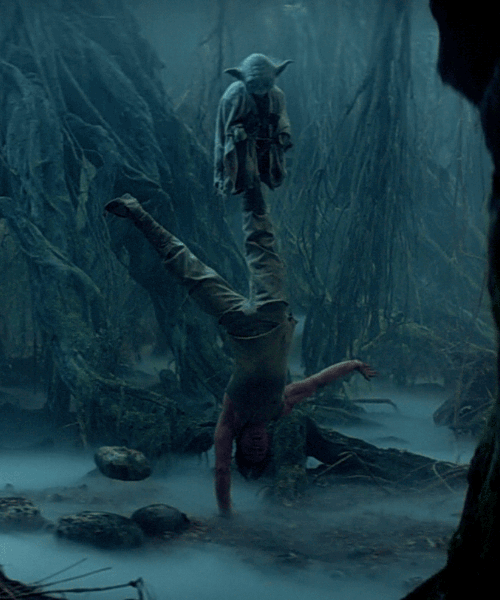
(Yes, I know this is technically three films, with three different directors and independent histories, but I didn’t feel like listing them all separately.)
2. The Lord of the Rings: The Fellowship of the Ring
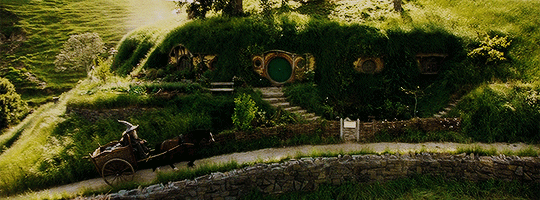
Ironically, I love the first Peter Jackson movie, but not any of the subsequent ones. Which is not to say they’re necessarily bad movies, but they’re not the ones I’d want on endless loop. (Part of this is because The Two Towers and The Return of the King are essentially war movies, and also because I have to watch Faramir act OOC, which hurts my soul.)
3. The Secret Garden
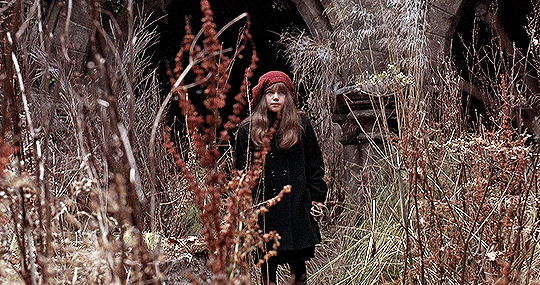
4. The Matrix
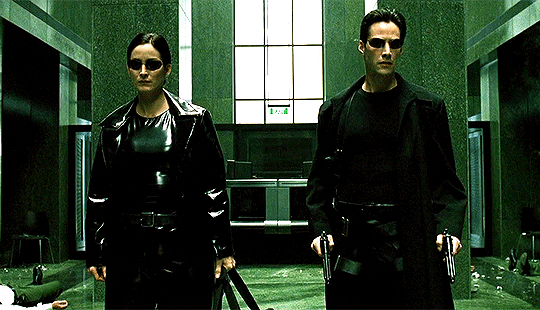
I actually don’t have strong feelings about Reloaded and Revolutions--like, the actual plot is weird, but I am so not watching these films for plot.
5. Return to Oz
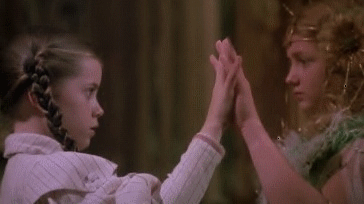
6. Inception

7. Labyrinth
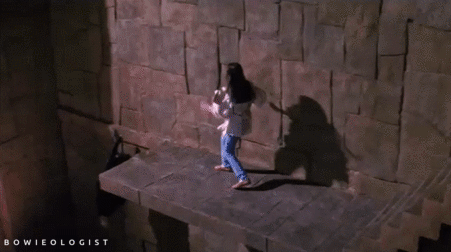
8. The Terminator
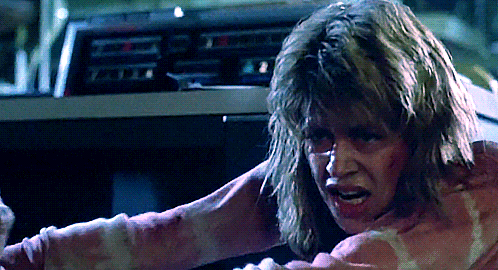
Don’t get me wrong, Terminator 2 has a lot going for it, but it’s not the one that I can’t stop thinking about (except for that one deleted scene with Michael Biehn, which is a totally different story).
Thoughts and Themes:
So at first glance, it seems like I have two separate categories: ‘80s and ‘90s-’00s films. Or maybe it’s sci-fi and fantasy? The Secret Garden is the only one that even approaches some kind of realism, and even that is a pastoral kind of world that would not be out of place in the more peaceful parts of, say, Middle-Earth (especially Fourth Age). How about high-tech vs. low-tech, or cyberpunk vs. fairy tale? Or, even better, what about reality vs. illusion (or story vs. truth if you prefer)--which is also a major tension within every film on this list?
I’ll also note that most of these films have an epic color palette, with memorable landscapes that either serve as characters in and of themselves, or symbolize the mental states of various characters. These films are beautiful works of art, reveling in The Aesthetic, whether that’s the idyllic peacefulness of the Shire or the grimy back alleys of 1980s Los Angeles.
The thing that really got me when I laid it out like this--the thing I hadn’t noticed before--was that all of these involve a (sometimes literal) rebirth, transition, or journey from darkness to light (or light to darkness to light again, depending on the work). You could also substitute life and death here, and not change much.
This is, again, often quite literal: Sarah moves underground in Labyrinth, the Fellowship descends into the Mines of Moria, the secret garden comes to life with the spring, Dorothy confronts the Nome King in his underground lair. Neo wakes up to find himself naked and soaked to the skin, and flushed down the tubes like garbage, in a literal hellscape where the machines destroyed the sun (a motif that also appears in Terminator’s dystopian future), then literally dies and is resurrected at the end of the film. Luke goes underground to confront his own double--another recurring theme!--on Dagobah.
Duality and the exploration of one’s soul through another world is HUGE big theme--or, to put it another way, The internal mirrors the external. This is a huge motif of Inception, which is a literal inward journey into a character’s psyche; and you could also make the argument that both Return to Oz and Labyrinth cover similar territory. Is Oz real, or is it in Dorothy’s head? Is Ozma a part of her, or is Ozma a separate entity? Is Jareth a real foe or is he the embodiment of Sarah’s fears and desires, a fantasy she concocts based on a story in a book? And Frodo realizes he’s not so different from Gollum, that the sad shriveled creature is what he could become if he fails at his task--and, ironically, his kindness to Gollum is what allows the quest to succeed when Frodo finally succumbs to temptation.
Frodo in the The Fellowship of the Ring sees the world differently when he wears the One Ring, and it’s terrifying. Sarah Connor realizes that she’s left her ordinary world behind and crossed into Kyle and the Terminator’s reality in a moving speech, and The Matrix doesn’t even try to be subtle. Even The Secret Garden uses the eponymous garden as a metaphor for the blossoming of Mary’s own soul, and the souls of those around her (especially her uncle and cousin, but also Ben Weatherstaff).
These stories are also concerned with ecology, though it’s usually a background motif, since the main focus is on saving the world (or what’s left of it, i.e, humans). The Shire is paradise; Mordor is a desolate hellscape, dominated by a giant volcano. Kyle Reese breaks down over the beauty of the world, and Mary Lennox seeks to bring the lost garden back to life. Dorothy retreats elsewhere after the grey grimness of Kansas/the mental hospital.
There’s also a real tension concerning humans’ relationship to technology in these films. The Matrix is an illusion, and machines control the earth. Or the machines don’t even bother farming humans and aim to kill ‘em all. Saruman literally transforms Isengard from a tree-lined field to an industrial hellscape. The mental institution uses that freaky electrical machine on Dorothy. Star Wars is more accepting of droids and technology, but even there, there’s tension: Obi-wan calls Darth Vader “more machine than man,” and it’s not a compliment; the Death Star is built to obliterate entire planets and must be stopped twice.
I’d argue this theme goes deeper than human/tech--it’s really human/other, with technology providing one kind of other. There’s human-alien interactions in Star Wars and Labyrinth, not to mention Mary’s relationship with the robin in The Secret Garden, Dorothy’s friendship with Jack Pumpkinhead and the Gump. On a less friendly note, Frodo’s relationship with Gollum is the emotional crux of the Lord of the Rings.
These films also feature the classic hero’s journey, but often through a female lens. The protagonist usually has no special skills other than their strong moral character and determination--or even if they do have skills (like Ariadne*), they still serve as an audience surrogate or substitute, a stranger to the new worlds they visit. The protagonist has at least one faithful friend/companion/love interest to help them (sometimes even a team/found family), and often a mentor as well (who may or may not be a crusty eccentric). In the end, the characters must take control of their own destiny--Frodo chooses to leave the Fellowship, Luke throws away his lightsaber rather than kill his father, Sarah declares to Jareth “You have no power over me”. Sarah Connor yells, “On your feet, soldier!” and keeps going to the bitter end, and Mary Lennox is unafraid of her bratty cousin’s wrath and puts a stop to it when everyone else enables him.
*(As an aside, I know Ariadne’s not the main character in Inception, but I find the actual main character way less interesting, so she’s the one I focus on, just like I find Trinity far more compelling than Neo.)
Characters often have Meaningful Names: Morpheus, Trinity, Neo; Ariadne; Luke Skywalker, Han Solo. These films also feature a question of fate and inevitability - Luke has precognitive visions, Neo consults the Oracle, Sarah is told “there is no fate but what we make for ourselves,” with Kyle serving as an oracle of sorts with messages from the future to come. The Mirror of Galadriel shows possible futures for the Shire, too.
Another theme is that the protagonist must suffer and/or work hard for their transformation. Mary has to do the actual work of gardening; Luke has to sweat and do handstands (beautifully, I might add); Frodo has to walk to Mount Doom; Sarah has to walk the labyrinth, and Sarah Connor has to survive a fucking nightmare. Dorothy has to rescue the royal family of Ev and free Ozma; Ariadne has to design a dream-puzzle for the heist to work. Even Neo has to train with Morpheus--though he’s able to use cheat codes to download martial arts directly into his brain without having to sweat for it; his real journey is in self-confidence.
In keeping with the stunning visuals, impossible feats are regularly featured, and excellent, cutting-edge-for-their-time special effects are prominent. Many also feature stunning fight scenes--the classic Luke vs. Vader duel on Cloud City; the “I know Kung fu” sequence in The Matrix; the clashes in The Fellowship of the Ring. Jareth has some excellent moves in Labyrinth, too, although he’s more inclined to dance than traditional battles.
I couldn’t resist contrasting my favorite moment in Return to Oz--rescuing Ozma from the mirror prison--with Ariadne shattering her own reflection in Inception, because that is such a moment for me, encapsulating all of the reality/illusion, internal/external, self/other dichotomies I mentioned above. (See also the Mirror of Galadriel above.) Inception and Labyrinth also share the motif of impossible Escher staircases, which I freakin’ adore.
It will probably come as no surprise to note that I also enjoyed films like The Dark Crystal, The Neverending Story, and What Dreams May Come, which tap into similar themes and imagery. You’ll probably be able to guess that The Sword in the Stone is my favorite animated Disney film, too.
I also love a number of Asian films like Hero, House of Flying Daggers, and Crouching Tiger, Hidden Dragon, all of which feature beautiful landscapes and color palettes, stunning fight scenes and special effects, along with a healthy dose of the fantastic, and a focus on story vs. reality (often with a plot twist or surprise reveal at the end). This is unsurprising when you consider the strong debt both Star Wars and The Matrix owe to Asian cinema in terms of style, plot, and aesthetic. In those films, the tension is more society vs. self, but duality is still very strongly present.
If you notice any other patterns or recurring themes, let me know; I’d love to hear them! Also, if you can think of any other movies I might enjoy based on this, let me know.
4 notes
·
View notes
Text
Satoshi Kon Will Always Be in Our Memories
Today, director and visionary Satoshi Kon would have been 55 years-old. Born October 12th 1963 in Hokkaido, Kon studied at Musashino Art University, and later became one of the most respected Japanese film directors of all time. While Kon is most well-known for his film Paprika (inspired by Yasutaka Tsutsui’s novel) Kon’s early career is just as rich and worthy of reflecting on as his break-out hits. Kon was, without a doubt, a master of depicting the messy inside-outs of psychological trauma and the anxieties of Japanese society. His chosen form, animation, only heightened this sense of unease in an often brutal and unforgiving world. Reflecting on the early works in Kon’s animation career, it only becomes more apparent that, regardless of how you might know his work, Kon has proven himself to constantly redefine our notion of the surreal, ourselves, and what anime can be.
A First Taste of Blood
The early career of Satoshi Kon is, in part, owed to the success of Akira author Katsuhiro Otomo. Otomo began his career in anime in 1987, working on the science-fiction anthology film Neo-Tokyo just before the debut of the 1988 adaptation of Akira. In his book, Satoshi Kon: The Illusionist, critic Andrew Osmand writes that Kon was working under Otomo as an assistant on the Akira manga sometime after the movie. This close association with Otomo’s style and stories would later culminate in Kon working as a key animator and art director for the 1991 film Roujin Z, also written by Otomo.
Roujin Z is, on the surface, a film about technology for Japan’s growing eldery population superseding its creators. It is tinged with the visual tension, claustrophobia, and strangeness that Kon would capitalize on in his iconic 1997 thriller Perfect Blue. One shot, in particular reminds me of Perfect Blue’s pop idol Mima: the student nurse character, Haruko, cleaning floors with a stained glass backdrop. Both young women are intensely dedicated to their careers until some catastrophic and deeply unworldly event strips them of normalcy. However, it isn’t Haruko’s pysche that acts as the film’s catalyst, but rather that of the old man Kijuro, who is bound to a nuclear-powered smart hospital bed. Haunted by the memory of his late wife, Kijuro is somehow able to transform the bed into a walking mecha that adopts her personality and voice. It’s already surreal and unnerving, but Kon’s unique art direction depicting the urban, yet isolating world Kijuro and Haruko inhabit only enriches the power of Otomo's work.
While just a stepping stone into the anime industry, Kon was already proving to have a solid grasp of how art can convey a rich, troubled inner-life. Later seen in Perfect Blue and his television series Paranoia Agent, Kon has always employed a powerful pairing of place and psyche—always emphasizing that our awareness of our surroundings are always at the whim of our minds. This thematic hallmark has always been planted deep at the heart of Kon's most powerful work.
Magnetic Rose and a Promising Future
Back in the '80s and '90s, anime film anthologies were a hotbed of emerging talent. Maybe unsurprisingly, Satoshi Kon’s first big break as a writer was in the 1995 anthology Memories, where he produced both scripts, backgrounds, and layouts for the short Magnetic Rose—another science-fiction story based off Katsuhiro Otomo’s work. With music by Yoko Kanno, Magnetic Rose is almost like an early Kon-directed episode of Cowboy Bebop (a dream!), accompanied yet again by an unnerving cautionary tale of technology and the human mind.
Aboard the space vessel Corona, a crew receives an SOS signal from an unknown source. Two engineers, Heintz and Miguel, discover an abandoned space station on October 12th—Satoshi Kon’s birthday. Kon’s screenplay is powerful, striking the perfect balance of the fantastic and gruesome reality. Heintz and Miguel are entrapped into a shuttle overrun by a wayward AI, the last guardian of an opera singer named Eva who passed away alone and isolated after her lover’s mysterious death. At AI Eva’s whim, Heintz and Miguel both fall victim to their own memories and desires, all for the sake of their own grasp of reality before succumbing to the unforgiving void of space. It is far less sympathetic than Perfect Blue or Paprika for its protagonist's emotional shortcomings—in a way, this is Kon at his unpolished best. Magnetic Rose is one of Kon’s strongest works, and with its unflinching depiction of the human psyche, it no doubt proves that Kon was pioneering long before his directorial debut.
The House Mima Built
After the success of Memories, Kon launched his directorial career with Perfect Blue, an adaptation of the novel by author Yoshikazu Takeuchi. For the first time, Kon had near total creative control of his films; unlike his previous projects, Perfect Blue’s art direction needed to be built from the ground-up. Without the blueprint of a preceding manga or character designs, the story of Mima Kirigoe, a pop idol with a split personality and a near-supernatural stalker, was entirely in his capable hands.
The role of memories in Perfect Blue isn’t unlike that of Magnetic Rose or Roujin Z—Mima in her pursuit to seek a new career as an actress, cannot escape her complicated past. Mima's troubled history joins Kon's dark gallery of thematic conflict: man and machine, man and evil opera singing AI, man and weird internet stalker. Kon’s characters are always moving forward, either it be Mima running away from her phantom pop idol other, or Paprika herself being chased down a dream hallway. Kon’s characters are consistently running away from, if not literally themselves, a surreal entity that is everything they hate or scared of becoming. Kon’s second film, Millennium Actress, solidified his talent as a filmmaker and of course, the rest is well-documented history.
In the year between Magnetic Rose and Perfect Blue's release, Kon wrote the manga Opus, his final work before fully transitioning to animation. While never completed, Opus tells the story of a manga artist who cannot finish his long-running series after his main characters mysteriously becomes sentient and prolongs the final chapter's release. In a way, Opus is an appropriate predecessor to everything Kon’s directorial career is: art that reflects the artist himself, the audience second. Life imitates art, in that after passing on August 24th 2010 of pancreatic cancer, Kon never finished his final projects. A month after his death, Kon was honored in TIME, where late film critic Richard Corliss wrote: "In his art, in his life and in his grace in leaving it, Satoshi Kon was a hero, first class."
Today, I hope both old and new fans of Kon’s films are able to reflect on his earlier works and appreciate the sensitivity and passion in which he pursued his craft. He was, beyond a talented animator and artist, a man deeply devoted to his colleagues and those who supported his ambitious endeavors. Satoshi Kon will always be in our memories, not only as a director, but as someone who completely transformed our relation to art for the better.
How has Satoshi Kon's work changed your life? Let us know in the comments!
------
Blake Planty is a writer who loves his cat. He likes old mecha anime, computer games, books, and black coffee. His twitter is @_dispossessed. His bylines include Fanbyte, Unwinnable, and more. His newsletter is Boy Toy Box.
Do you love writing? Do you love anime? If you have an idea for a features story, pitch it to Crunchyroll Features!
2 notes
·
View notes
Audio
Prepare to embark on a funk inspired, psychedelic trip of a tune with SAVI MINDS as he melds 90′s disco with indie rock on Lazy. It’s been half a year since Los Angeles’ Mikale D’Andrea enthralled us with gauzy strums and gently spiraling synths on debut single Dreaming. From those mellow psych rock and chill shoegaze beginnings, savvy SAVI MINDS now mesmerizes us with luscious shimmering neo-psychedelia on his sophomore offering, a sleek grooving track that cements his status as a rising artist to watch in the indie scene. SAVI MINDS explains that the song is about his experience growing up in an abusive household, and how that affected the person he is today. He says, “I’ve always written songs about my life experiences, but this is definitely the first time that I’m writing about such a specific part of my life.” He goes on to add, “Living at home wasn’t easy for me and my sister. Name calling was pretty common. It was hard to be a confident kid when everything I did at home, was shot down. There was no way to win, and it felt like I couldn’t breathe.” Revisit debut single DREAMING via our feature, here. You can also stream/download Lazy, here.
#SAVI MINDS#LAZY#indie rock#nu-disco#nu disco#disco#disco rock#dance rock#disco funk#psych rock#psychedelic rock#music#song#neo-psychedelia#indie#da#elect#dance#disco house#rock#funk
2 notes
·
View notes
Note
🎧
THE BRIAN JONESTOWN MASSACRE + THE TELESCOPES — BEFORE YOU FORGET
this was released earlier this year between two of my favourite shoegaze / neo-psych bands and i don’t actually really know the story behind it. the brian jonestown massacre are a californian neo-psych band which cropped up in the early 90’s, they’re one of my favourite bands & i truly do believe in their singer, anton newcombe, even if he’s been temperamental & has a bad rep. this band fills me with life.
0 notes
Text
draft 1
<Mass media and Popular Culture >
<Pop Art’s seven influential decades>
Abstract (100-150 words)
Numerous external factors are constantly shaping design; one of the driving forces is current events. When designers are predicting trends, it is crucial to examine the state of the public psyche. Recent and upcoming events shape these predictions as these events change our fears, concerns and desires.
Historically, art had been carried by principles of history and conservative values based on previous philosophies and styles. However, the late 18th century saw some artists move away from these ideals and became a time for expression. The modern art movement encompassed a variety of art styles such as Cubism, Dada and Surrealism, born from these new ideas and carried a fresh take on art. Pop Art emerged as a descendant of Dada and quickly became a global trend for design, shaping society with its vision of blurring boundaries between "high" art and "low" culture. This paper will focus on the success of Pop Art and how it has evolved since its arrival.
Contextual knowledge (500-750 words)
In the early 1950s, Pop Art emerged in Britain and America, inspired by commercial and popular culture. However, it didn't have a specific style or attitude. Instead, it was defined as a response to commodity-driven values in the postwar era, commonly using widely recognised household and shared objects as subject matter. (T. Editors of Encyclopaedia, 2021). After the Second World War, young artists were coming of age. They were marginally affected by its traumas, "Instead, they were able to indulge in the product frenzy, and image deluge brought about by a rapidly growing consumer society." (Frigeri, 2018) While the movement may have started in Britain with artists Richard Hamilton and Eduardo Paolozzi and architects Alison and Peter Smithson, its reach would be felt and amplified by American artists like Andy Warhol, Roy Lichtenstein and Jasper Jones. They reached deeply into the culture, changing notions of fame, literature and fashion. The use of popular images as opposed to elitist culture emphasised the ironic and humorous side of art. It also served as a vehicle to equally portray the importance of something. Roy Lichtenstein described it as "Pop Art looks out into the world. It doesn't look like a painting of something; it looks like the thing itself" (Artspace Editors, 2017). Campbell's Soup Cans by Andy Warhol depicted this idea wholly by using 32 canvases with each canned soup variety screen printed onto them. Pop art was the first movement to declare that advertising and commercial endeavours were forms of art. With the advent of pop art, trends and fashions have become an all-encompassing phenomenon that seeks to merge the whole cultural endeavour into a singular aesthetic style (Morley, 2013). The movement had sociopolitical implications that remain realised today. In this regard, pop art is seen as more of a cultural movement or a social movement.
The influence of pop art goes beyond the art world by influencing the business world, transforming culture continuously into an ever more excellent artistic display to engage with the reality of capitalism desperately. The significance of pop art is that economic and aesthetic considerations are not in opposition, which may have been the case in the traditional Avante Garde. However, not all pop artists were eager about capitalism—many used parody and irony to subvert capitalism. But pop art changed the notion that art should stay segmented from the popular culture (Morley, 2013). In a way, it sought to promote capitalism's good aspects and allow the harmful elements to fall away. Pop art continued firm into the 1980s and 90s, with the same ideas thematically connected but with the current world landscape. Jeff Koons became a central figure in a movement called "Neo-Pop", which also managed to capture the international kitsch of the same commercialism that had characterised the 60's. With famous takes on the genre like his pieces "Balloon Dogs", shiny sculptures that resembled the twisted balloon animals made by children's entertainers, and other mass-produced objects like vacuum cleaners. Coco Dávez, another influential pop artist, draws on the same themes of the genre but interprets the format in a minimalistic fashion. In her acrylic on canvas works, facial features are left blank in her 2010 "Faceless" series that gathers cultural and historical icons who have inspired her, resulting in portraits with an air of playfulness by inviting the viewer to guess the subject. (The Next Generation of Pop Artists, 2020) The artists today who have kept the pop art style alive can express the same ideals 40 years ago while developing it, which has kept it relevant. Because of the ever-changing world we live in, the ability to express socio-political ideas will always remain.
Methods (500-750 words)
Pop artists desired straightforwardness in their work, using bold amounts of primary colours, often straight from the can or tube of paint. One of the early adopters of the style, Roy Lichtenstein, often involved stencils, evoking the look and feel of commercial printing processes to his work. Lichtenstein endeavoured to make his works appear machine-made through primary colours, thick outlines, and Benday dots (Roy Lichtenstein | MoMA, n.d.). The adoption of commercial advertising methods like silk screening or producing multiples downplays the artist's hand's importance. Moreover, it undermines the idea of originality and preciousness, in contrast to the Abstract Expressionists' highly expressive, large-scale abstract paintings. The work of the latter had dominated postwar American art. Instead, pop artists favoured realism, everyday imagery, the mundane, and heavy doses of irony and wit. They challenged traditional boundaries between mediums and techniques, merging painting with photography and printmaking, combining handmade and readymade or mass-produced elements, and bringing together objects, images, and sometimes text to make new meaning. ("What Is Pop Art?," 2018). Pop art has paved the way for new styles and genres to apply the same techniques more recently.
The rise of digital technologies has shaped our society exponentially since the early 1980s. It has continuously been at the forefront for evolving processes already available and streamlining them. This wave of innovation has brought significant change to the art and graphic design industry, giving designers more tools than ever imaginable (Boitel, 2019). It allows for the ability to make and engage in a new digital landscape, furthering the idea that art can be for anybody, giving way to a world where art is no longer for the most elite high class but anyone with a passion. You can find an example of this shift in process in Julian Opies, "Ruth with cigarette 5", where the highly stylised treatment Opie gives his subjects features thick black outlines filled with solid areas of flat colour (The Next Generation of Pop Artists, 2020). Lambda Prints on Fujicolour Digital Archival Paper combines pop art and minimalism with a wholly contemporary sensibility. Opie's portraits convey pop art's bold aesthetic and communicate its ability to make art accessible. One of the most acclaimed artists to emerge from postwar Asia, Takashi Murakami is known for his contemporary pop synthesis of fine art and popular culture, particularly his boldly graphic and colourful anime and manga cartoon style. His list of collaborations with major brands like Louis Vuitton has seen his infamous Murakashi flowers plastered on fine art, pop culture, fashion, to commercial products (Anita Louise, 2018).
Many pop artworks have seen the shift to digital formats, where their accessibility has grown dramatically. Using the internet as a tool for exposure and connection, many artists have found themselves at the front of marketing, advertising and product launches. Collaboration in the 21st century has never been so active through the use of the internet. Artist and Designer Malika Favre has taken her distinct bold, minimal style, a combination regarded as Pop art meeting Optical art, to the frontlines of campaign launches and brand identities. Her work is predominantly digital, utilising vector-based software like Adobe Illustrator (Garrick, 2017). The use of digital means to produce artwork has become increasingly more important to creators and consumers. Brands have realised the need for individual creators to help expand their reach. In today's digital landscape, there exists an undeniable demand for high-quality content. Platforms like Instagram or Youtube already have a substantial abundance of creatives that cater to a vast amount of audiences. For brands, the advantages go beyond audience expansion. Artistic expression plays a huge role in branding; by creating a unique brand presence that stands out beyond the traditional advertising methods, companies are developing new formats of reaching out to audiences in a more refined way. (Group, 2020) Gone are the days when internal design teams dictate what a product or launch may look like; collaboration has given way for businesses to connect with creatives in a more welcoming light.
Conclusion (300-500 words)
The Pop Art movement was significant because it made art accessible to the masses, not just to the elite. As the style drew inspiration from commercial figures and cultural moments, the work was recognised and respected among the general public. Its reach from Britain and America expanded globally, with artists from other countries using the format as a vehicle to carry their perspectives and ideas in the art relating to their realities. The style is relevant because the combination of objects, images, and sometimes text makes new meanings and evokes an overwhelming feeling of nostalgia that can arise from such things (The Influence of Pop Art in Hyperrealism, 2016). Modern-day technology has enabled us to mass-produce more efficiently; this also applies to how art is created and distributed, making the reach of Pop Art even larger. Social media has a new generation of artists extending and redefining its tenants in new and inventive ways. Pop art's continued impact on post-modernist aesthetics is reflected in various new advertising strategies where the line between "high" and "low" art blurs further. Strategically Pop art advertising is an enriching brand strategy that creates beautiful harmony between art and marketing concepts. It has become an essential part of a culture where products, furniture, clothing is still mass-produced, referencing aspects of the style and bringing light to new commercial and popular trends of the modern-day world. It still manages to take a humorous and ironic approach more relevant to society's constantly changing opinions. Today's fashion trends are one of the most telling indicators that pop art is still popular today as it was in the past (Dačić, 2015). Pop art still thrives on the cultural values that led to its origin. With mass media and mass production continuing to succeed, it leaves a window for creativity fuelled by the reflective values of tomorrow's generation.
References
T. Editors of Encyclopaedia. (2021, August 25). Pop art. Encyclopedia Britannica. https://www.britannica.com/art/Pop-art
Frigeri, F. (2018). Pop Art. Thames & Hudson.
Artspace Editors. (2017, September 22). In This 1963 Interview, Roy Lichtenstein “Doubts” Pop Art Will Have a Lasting Influence. Artspace. http://www.artspace.com/magazine/interviews_features/roy-lichtenstein-what-is-pop-art
Morley, A. (2013, October 17). Why is Pop Art Significant? | History of Pop Art. http://historyofpopart.onmason.com/why-is-pop-art-significant-2/
The Next Generation of Pop Artists. (2020, August 27). Maddox Gallery. https://maddoxgallery.com/news/105-the-next-generation-of-pop-artists-the-contemporary-artists-keeping-the-movement-alive-today/
Roy Lichtenstein | MoMA. (n.d.). The Museum of Modern Art. Retrieved October 19, 2021, from https://www.moma.org/artists/3542
What is Pop Art? Techniques, Artists, and Examples that Shaped the Movement. (2018, September 17). Invaluable. https://www.invaluable.com/blog/what-is-pop-art/
Boitel, R. (2019, January 17). How has technology affected the arts? The INews Network. https://inewsnetwork.net/4723/arts-entertainment/how-has-technology-affected-the-arts/
Anita Louise, H. (2018, April 24). Why is Takashi Murakami So Popular? The Japanese Artist Takashi Murakami – Anita Louise Art. https://anitalouiseart.com/why-is-takashi-murakami-so-popular-the-japanese-artist-takashi-murakami/
Garrick, W. (2017, November 30). Malika Favre. Communication Arts. https://www.commarts.com/features/malika-favre
Group, T. F. (2020, November 4). Why Brands need to Collaborate with Artists. https://thefame.my/why-brands-need-to-collaborate-artists/, https://thefame.my/why-brands-need-to-collaborate-artists/
The influence of pop art in hyperrealism. (2016, April 13). Plus One Gallery. https://www.plusonegallery.com/blog/45/
Dačić, A. (2015, November 8). The Impact of Pop Art on the World of Fashion—From Art to Industry and Back. Widewalls. https://www.widewalls.ch/magazine/pop-art-fashion-industry
0 notes
Link
I chose to post this Portland area obituary because over the years, as @newbombturks started touring more, I would hear tales from lucky folks up in the great northwest, specifically from around Dead Moon’s Clackamas, OR, homebase, about how great they were live; or from people in Europe, as in the early 1990s, we’d get to clubs and see posters that they had played two weeks ago or were playing next month, etc., and let out a large, collective “Fuck!” It made more sense for Dead Moon to play over there. They were the quintessential “huge in Europe” band. Their rep there was nothing less than heroes over in Europe’s government-funded youth centers or craggly rock clubs. We need not cover the whys and hows of how American bands fall in love with touring in Europe, where clubs and bookers actually believe in activities like eating food and having a place to sleep.
But then here’s the thing. As Fred, his amazing wife Toody, and that indestructible motor for the whole midnight Moon drive, Andrew Loomis, got older, they seemed to tour more. I don’t know, maybe they started to see, or at least imagine, some distant light at the end of that long, midnight road of rock’n’roll they’d traveled for so long. And like many bands lucky enough to get to tour a lot, sometimes it takes a few years to appreciate how lucky you are to be in that position, just in time to wonder if the body still can. Fred and Dead Moon answered that particular question tenfold.
Dead Moon is my favorite of all Fred’s six-string excursions, but try to track down those Rats albums! I’m remembering how -- even as a died-in-the-Chuck Taylors punk fan who grew up with “DIY” as the given art-life strategy -- the stories of Dead Moon pressing their own records at home on their own label just blew me away. I finally got to see Dead Moon a few times the ‘90s, and a couple more times in NYC in the last decade. I got to see Pierced Arrows on their very first tour out here too. And of course upon hearing the news yesterday, I instantly fell into that guilt-state that increases as you get older: “Fuck, I should’ve seen them that last time they came through.” I had to work or whatever fucking forgettable excuse kept me from shaking hands with Fred again.
Unlike the endless stream of admirers in my Facebook feed, I don’t have tons of stories of all-night conversations with Fred, though I had some good small ones over the years. I interviewed him for my book. And I especially remember seeing Fred and Toody to the side of the stage at the Las Vegas Shakedown fest in 2000, as we played our set, right before Dead Moon. I came down from the stage after we ended, and there was Fred to smack me on the back and say “Great show, don’t know how we’re following that!” The “Are you kidding??!!”s came flowing, and we laughed and chatted a little more as he moved his amps and such. They always did all their moving gear shit, and everything else. They were fucking amazing that night, like any other time I saw them.

Dead Moon, 2014 - Photo by Emma Browne
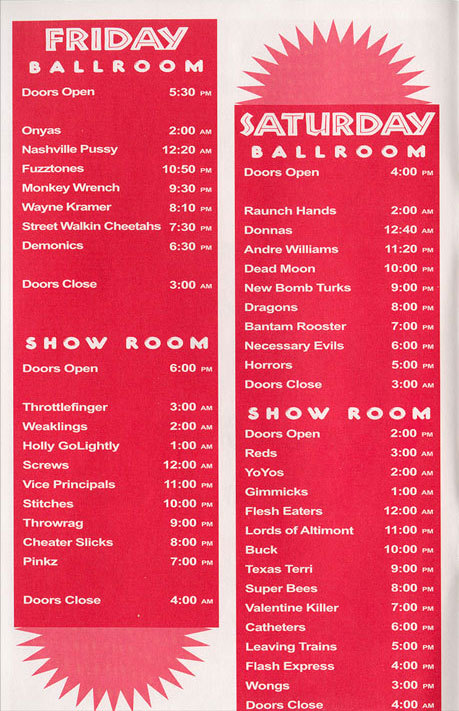
I could go on here forever, but it’s petty impossible to encapsulate such a unique figure as Fred Cole. While physically and spiritually staying alive to live the rock’n’roll mythos for his whole life, he liquidly moved from psych-garage to graveyard proto-metal to trash punk to a grandaddy of neo-garage rock, all sounding eerily united like, well, no other single figure I can think of. It’s a testament alone to just stick around for that long, so invested, inspired, and inspiring. But unlike many similar lifers you could recall, Cole never twisted into his experimentations because of trend-hopping or a last-ditch shot at figuring out “what the kids liked.” Fred’s only directive seemed to be creating with his equally-inspiring wife and playing that stripped guitar until he couldn’t, glowing from dank stage after stage like the hazy glow of street lights on that long nighttime highway his bands drove down. May the last light burn with even half the intensity of a Dead Moon show.
Thanks Fred.

youtube
youtube
7 notes
·
View notes
Text

A Dream in Sound by Elf Power
Arena Rock Recording Company / Elephant 6
1999
Indie Rock / Indie Pop / Lo-Fi / Neo-Psychedelia / Psychedelic Pop / Indie Folk
#indie rock#indie#indie music#rock#indie pop#lo-fi#neo psychedelia#neo psych#psychedelic pop#pop#indie folk#folk#folk music#music#90s#90s music#90's#90's music
2 notes
·
View notes
Text
Let me tell you about my favorite band, bloodthirsty butchers.
bloodthirsty butchers were a Japanese band active from 1988-2013. (Yes, it is stylized as “bloodthirsty butchers,” without caps. Don’t let Wikipedia lie to you, it’s written that way in all their music videos and almost all their album covers.) Most websites have trouble categorizing them, so they go with “punk” or “indie.” Indie doesn’t mean anything, of course. Early on they probably fit the Punk label pretty well, akin to a slightly heavier Blue Hearts. At their peak, they were more like a punk/neo-psych fusion band. Most of the songs were high-energy, fast-paced, with unmusical yelling vocals and awesome, unique, lengthy guitar solos. Hideshi Yokimura couldn’t sing, but his guitar playing was entertaining as hell. I won’t vouch for the skill involved--I don’t play guitar and can’t tell technical ability. But I can tell whether someone builds tension well, and as far as I’m concerned he was the best ever.
The best bloodthirsty butchers songs end with several minutes of guitar noodling, sometimes longer than the lyrical portion of the song. Y’know Sleater-Kinney’s Let’s Call It Love? Y’know how it’s their best song? bloodthirsty butchers were basically ~20 years of that.
Here’s a rough guide to bloodthirsty butchers. If we go chronologically we’ll start and end kinda weak, so let’s jump around and find ourselves in the middle. ‘Kay? And if you don’t care, there’ll be a nice tl;dr at the end you can look at.
Bloodthirsty Butchers [1990]
I’m Standing Nowhere [1993]
Lukewarm Wind [1994]
Their first albums were 2 cassettes released in 1988 and 1989. They are basically impossible to find, unless you want to shell out the $400 for the complete box set. I can’t comment on how they sound.
I can comment on the 3 albums released in the first half of the 90s. This is the period when the butchers were a kinda by-the-books Japanese punk band. The songs are mostly short, fairly catchy, very poorly produced, and loud. They’re all worth a listen, if you like that kind of music. (I do.) Of the 3, Lukewarm Wind is by far the best. The songs are ordered to make a more coherent sonic narrative. Occasionally it takes a break from LOUD FAST.
I don’t have a whole lot to say here. “ALLIGATOR” is a popular song but I’m not crazy about it. I’m more a fan of stuff like “Pressure,” which is a great way to end a record. If you like that song, look at Lukewarm Wind and work backwards from there.
No Album Mudai [2010]
Youth [2013]
Let’s jump way forward, to the end of the butchers. Yokimura, the band lead, died in 2013, so Youth is most likely their last album, unless for some reason they decide to plod on with a different lead or there’s enough new material already recorded to put out one more album.
These albums aren’t great! No Album Mudai has 2 songs worth listening to, at the very end. They are good to hear in order: Ocean, Curve. They work well together. Almost nothing else on this album works. It all sounds tired and by-the-books.
Youth is a bit better on average, but doesn’t have any songs as good as Ocean or Curve. This isn’t super surprising. A lot of bands get boring after 25 years. Cheers to the butchers for at least putting out something listenable. Compare to, say, most of Nick Cave’s recent albums, which leap between “kinda good” and “OH MY GOD TURN IT OFF.” Putting out good albums for more than a decade is hard!
Ok, now that leaves 7 non-compilation albums, plus some good EPs and live stuff, between 1994 and 2010. Also stuff I probably don’t have because English websites aren’t as reliable in regard to Japanese bands. Let’s break them down.
1999 - 2001: The slow, plodding stuff
Mikansei [1999]
Yamane [2001]
2 of the top 5 albums for sure.
Mikansei (which means “Incomplete”) is one of the first albums with serious neo-psych elements. (I skipped the first. We’ll get to it later.) It opens with “Faust,” which is not slow or plodding at all. I gave that description more because of “Boku,” which is good but not interesting enough to be as long as it is, “Mikansei,” which is about as good as title tracks can get, and “Sankaku,” which is fairly energetic but ends with about 10 minutes of kickass guitaring that isn’t energetic for much of the time. I feel like these songs give Mikansei a much more downbeat feel than previous albums. If you want to know why I say they’re punk/neo-psych fusion, give any of these a listen, especially Sankaku. (You might find it under “「△」.” “Sankaku” means triangle and sometimes the title is stylized that way.) This one has its rough spots and is clearly a transition album, but it’s one of my favorites. Someone must really like this album, because there’s easily-available romanization and English translation of most of the songs online--not so for the other albums, except Kocorono.
Yamane was the first butchers album I ever heard in full, and it was love at first listen. Almost every butchers record has at least 1 instrumental song, and Wagamama No Hotori is my favorite. It fits so beautifully in its place before “-100%.” I’m sorry I can’t find a link. Yamane is a lot slower than other butchers albums. It begins with a rather skippable trumpet opening, then opens proper strong with “Happy End.” It is not a happy-sounding song but sonically, the proper reverb use and repetitive structure and beautiful guitars make it a personal favorite. The last 3 songs on the album are “-100%,” “Moeru, Omoi,” and “-100% No.2.” Both of the 100%s have the same bass line and mellow melody. They’re relatively peaceful and lovely, if you like noise the same way I do. “Moeru, Omoi” is a long, intense divider between them, where every word is screamed as loudly as Yokimura can. The buildup around the 4-minute mark is the reason I love this band so much. “-100% No.2″ is the best song on the album. The production is immaculate, “-100% No.2″ has this fuzzy distortion that makes me feel so relaxed and happy. I’m sorry I can’t find links to any of these online. It is some of the best butchers material there is.
2003 - 2004: The weird stuff
Kōya ni Okeru bloodthirsty butcher [2003]
Birdy [2004]
Neither of these these rank among my favorites, but they undeniably have some super good songs.
Kōya ni Okeru has “Lucky Man,” which feels a bit like a return-to-roots attempt. This is what those first 3 albums would have sounded like if they had more experience back then. “Dorama” is... an “Obladi Oblada” cover? More or less? There’s no way it’s an exact translation, but it is almost the exact melody. “ 悲しみをぶっとばせ!“ is an instrumental song that’s mostly good except it has this really annoying synth around the 2:50 mark. There are a few segments where they experiment with atonal sounds, but it doesn’t work well for them.
Birdy opens with two of their best songs: “JACK NICOLSON” is one of their most popular, I believe. It also has a neat video, check it out (though cw for suicide attempt). The last line of the chorus translates to “I want to be a bad role model.” “Birdy” is simple but fun. For a song released in 2004, it really sounds like something someone would have put out in the 90s in the US. It’s kinda downhill from there. “Love Supreme” is one of their better instrumental songs. Again, there’s atonal stuff that doesn’t work--the album’s real pitfall.
2005 - 2007: The FUCK YEAH stuff
Banging the Drum [2005]
Guitarist Wo Korosanaide [2007]
I’ll come back to Banging the Drum. There’s too much to say. But I want it to be clear it belongs in the FUCK YEAH category.
Guitarist Wo Korosanaide translates to “Don’t Kill the Guitarist.” It begins with “yeah#1″ and OH MY GOD, YES, THIS IS HOW YOU BEGIN AN ALBUM, FUCK YEAH FUCK YEAH FUCK YEAAAAAAAAAAAAAAAAH! This song RULES. It’s energetic as hell, dynamic enough to be more than a simple fast punk song, and is so very butchers in sound. It is, unfortunately, the highlight of the album. But there’s other really interesting stuff here, and nothing grating, so FUCK YEAH! I really like the female guest vocals on “Mushizu to taikutsu.” “Story” is like a better version of the type of songs that would be on No Album Mudai, their next album. This is solid work in general, even if it’s not their best.
1996, 2005: The stuff I skipped
Kocorono [1996]
Banging the Drum [2005]
I skipped them because, y’know, best for last.
Kocorono is probably their most popular album. There is a reason for this. It’s almost perfect 90s punk, with a narrative, evolving sound, musical callbacks, fantastic guitarwork, and my favorite guitar solo of all time ever. It’s another downbeat album, for the most part, but is the real start of the punk/psych fusion sound I love so much. Each song is a month, starting February and ending December. (A bit like Album of the Year.) The original album didn’t have “January,” but it’s on the 2010 re-release. It’s a better closer to the album than “December” and I recommend getting it. Every single song is great. If this post weren’t already so long, I’d want to go into my favorite parts down to the second of each. (Maybe later.) The awkward sax opening of “November” is the only thing I think doesn’t work. “July” is my favorite song ever. It is half guitar solo, wonderful, wonderful guitar solo. I could watch live performances of it all day. It is a true shame I’ll never get to see the butchers perform, because hearing this live would be a nigh-spiritual experience for me. I get goosebumps when I hear the opening.
Banging the Drum is my favorite album. I mean of any band, ever, not just bloodthirsty butchers. I don’t know that others feel the same--looking around at internet reviews, it seems other people like Guitarist wo Korosanaide more. But this is my blog, so I’m rambling about this one.
It begins with a kickass drum solo. (”Joshou”) That song leads into a high-energy punk song (”B2″) and from there it gets even better. Every song flows effortlessly into the next. Every song is interesting. Everything they try works, nothing sounds bad or grating or annoying for even a second. I find it hard to listen to any song in isolation--I need the whole album every time. At most, I can listen to the final two tracks--”No. 6″ and “Banging the Drum”--in tandem. They fit together far too well.
There are a some female vocals on this album (uncommon for the butchers), and they all sound great. “YAMAHA-1″ is the winner, in that regard. In “PLUS/MINUS” they act as lovely backup.
Track order is an art in itself--it’s why I almost always listen to whole albums rather than individual songs. I love the artistry involved in constructing a long sonic narrative. I think Banging the Drum has one of the most impressive album structures I’ve ever heard. It’s not quite Raining Blood (the best I know of), but everything fits together so, so well. (It helps that all the songs are great.) “Banging the Drum” is one of the best album outros ever.
Much like Yamane, the production works very well with the songs, and they have just the right amount of lovely fuzzy distortion. Again, I could go into every song by second and mention my favorite parts, but this is too long already. With that in consideration...
tl;dr
Listen to Kocorono and Banging the Drum. If you like either, listen to Yamane. If you like that, go for Mikansei, Guitarist wo Korosanaide, and maybe Birdy. Let bloodthirsty butchers into your heart. Amen.
4 notes
·
View notes
Text
heres my neo-psychedelia rate aka “i basically just rank mgmt and animal collective”
1) yes im counting hypnagogic pop as neo-psych 2) i know im missing a bunch of 90′s essentials but also listening to anything psych-influenced from before 2000 makes me feel miserable so, spiritualized is as far as i willingly go back
would love to post that to twitter but i can already anticipate all the reply guys getting on my dick about counting salad days and oracular spectacular as neo-psych lmfao
just because somethings radio friendly as all hell doesnt make it any less qualified to be neo-psych ! pom pom is poppy as hell but i don’t see y’all declaiming ariel pink with the same energy as mac demarco
3) i dont care if you think something on here isnt neo-psych 4) i love pop music
0 notes
Text
REM Sleep and Dreaming
Like I said I wanted to track my sleep cycles and see if there was any kind of pattern but, I also found out that being a college student I will never have a normal sleep schedule. So, what I have decided to do is see the difference between a night that I got only a few hours of sleep and when I had over 8.

The main difference that I can see is that I got a lot more REM sleep when I had more time to sleep. This does make sense because to enter REM sleep you have to be asleep for roughly 90 minutes and then have time to cycle back through to each stage. Another thing that correlates to the science behind sleep is the amount of time that I spent in the deep sleep stage. It is said that the first time that you enter the fourth stage or deep sleep it should be the longest of the night, which mine is. Every time after that it got shorter and shorter.
Like I have said before REM sleep is the stage of sleep that is most closely related to dreaming so I thought it would be interesting to look at the amount of dreams that I had that night. So, when I woke up the morning after I immediately grabbed a random piece of paper and wrote down what I could remember. Surprisingly or not so surprisingly I remembered quite a few. I remember having a dream about my roommate being a neo Nazi and being murdered by my best friend. Now to say where those dreams came from, I have no clue but, that is two more dreams than I could recall from the night that I only got 4 hours instead of 8. Is it because I had more REM sleep? Science suggests that that would be the cause but it also could have been the rum and coke I had before bed.
Rathus , S. A., Maheu, S. J., & Veenvliet, S. G. (2017). PSYCH Third Canadian Edition. Toronto: Lenore Taylor-Atkins.
0 notes
Text



Evergreen by Echo & The Bunnymen
London
1997
Alternative Rock / New Wave / Indie Rock / College Rock / Neo-Psychedelia / Jangle Pop
#alternative rock#alternative#alternative music#alt#alt rock#alt music#new wave#indie rock#indie#indie music#rock#college rock#neo psychedelia#neo psych#jangle pop#music#90s#90s music#90's#90's music
5 notes
·
View notes